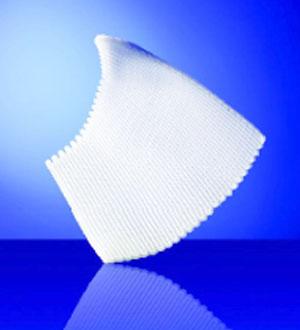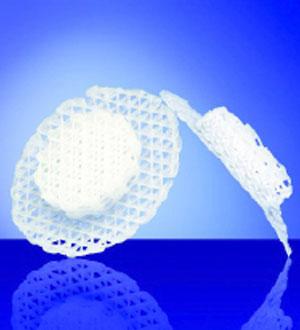 While medical science has created thousands of implants and devices that doctors can implant into the human body that save lives and improve patients quality of life, there are always risks involved. Not only the risks inherent with any surgical procedure, but having a foreign object inside of the body brings with it the risk of infection or the body simply rejecting its presence. These risks are of course weighed against what could happen without the implant and typically it is the better option. However ideally medical treatments work the best when there are no requirements for implanted devices, or those implanted devices are only temporary.
While medical science has created thousands of implants and devices that doctors can implant into the human body that save lives and improve patients quality of life, there are always risks involved. Not only the risks inherent with any surgical procedure, but having a foreign object inside of the body brings with it the risk of infection or the body simply rejecting its presence. These risks are of course weighed against what could happen without the implant and typically it is the better option. However ideally medical treatments work the best when there are no requirements for implanted devices, or those implanted devices are only temporary.
Beyond any associated health risks, there are also other reasons why medical implants are controversial or undesirable options for many patients. Religious or spiritual objections to body modification is a common reason that patients may choose to forgo implants for less effective or desirable treatments. Islam explicitly forbids body modification, specifically for aesthetic reasons, and while Islam typically makes exceptions for implants that serve a medical purpose it can still be an uncomfortable choice for many followers of Islam to make.
However, a Singapore-based manufacturer of bioresorbable medical implants believes that their products are a culturally-sympathetic option for many Muslims wary of long-term implantable devices. The customized, 3D printed bioresorbable polymer implants from Osteopore were developed for neurosurgical, orthopedic, and maxillofacial surgical use. Their implantable biostructures, primarily used to help repair broken or damaged bones, are made from a synthetic biologically active tissue that has been engineered to encourage the restoration of a patient’s skeleton.
“We 3D print bone scaffolds. The scaffold is implanted to provide sufficient load-bearing support but unlike plastic or titanium implants, this encourages tissue regeneration and breaks down over time. After 6-18 months, depending on the size of the wound and the type of tissue repair, the material will slowly break down,” Osteopore’s Lee Kean Sang explained to Khaleej Times at the Arab Health 2016 conference. “Body modifications are prohibited in Islam. If it is for a medical need, it is acceptable, but I think this product is more culturally friendly for this region. It is one step ahead of the current 3D-printed implants as they are permanently fixed in the body.”
Historically when a patient broke a bone the course of treatment was natural bone grafting that involved resetting the break and advising the patient to avoid putting weight on the break until it was completely healed. However that takes time, and many breaks can’t so easily be repaired so devices like pins were developed to hold bones together while they healed. But due to the efforts of companies like Osteopore treatments have shifted to tissue engineering that involves a scaffold device being implanted to provide load-bearing support and encourage the regeneration of tissue. These implanted devices, though, are often permanent and can never be entirely removed from the patient’s body.
- Osteomesh.
- Osteoplug.
In 1999 a group of Singaporean engineers and medical researchers developed a novel way to create scaffold devices using 3D printing technology that would encourage a more natural bone graft. Those same engineers and researchers would go on to found Osteopore, and further develop their platform to create their devices using an FDA-approved polymer called polycaprolactone (PCL). Because PCL is bioresorbable but has mechanical strength that is similar to trabecular bone, their products have virtually no undesirable side effects and will eventually be entirely replaced by the patient’s own bone tissue.
All of the Osteopore implants are custom made for each individual patient and then 3D printed in-house in order to create a precise fit with the patient’s anatomy. The scaffold is designed with unique architecture to allow for the infiltration of bone cells and blood vessels which play significant roles in healthy and rapid wound healing and tissue repair. Not only do bioresorbable scaffolds make sense medically, but Osteopore believes that they are an excellent alternative to traditional orthopedic implants for wary Muslim patients. What are your thoughts on these new implants? Discuss in the 3D Printed Implants for Muslims forum over on 3DPB.com.
Subscribe to Our Email Newsletter
Stay up-to-date on all the latest news from the 3D printing industry and receive information and offers from third party vendors.
Print Services
Upload your 3D Models and get them printed quickly and efficiently.
You May Also Like
The Dental Additive Manufacturing Market Could Nearly Double by 2033, According to AM Research
According to an AM Research report from 2024, the medical device industry, specifically in dentistry, prosthetics, and audiology, is expected to see significant growth as these segments continue to benefit from...
Heating Up: 3D Systems’ Scott Green Discusses 3D Printing’s Potential in the Data Center Industry
The relentless rise of NVIDIA, the steadily increasing pledges of major private and public investments in national infrastructure projects around the world, and the general cultural obsession with AI have...
AM Research Webinar Explores Continuum’s Sustainable Metal Additive Manufacturing Powders
Metal additive manufacturing (AM) powder supplier Continuum Powders is working to develop solutions that empower industries to reduce waste and optimize their resources. An independent life cycle assessment (LCA) of...
3D Printed Footwear Startup Koobz Lands $7.2M in Seed Round
California-based Koobz is focused on reshoring the U.S. footwear supply chain with advanced manufacturing processes, including 3D printing. The startup just announced that it has added $6 million to its...




































